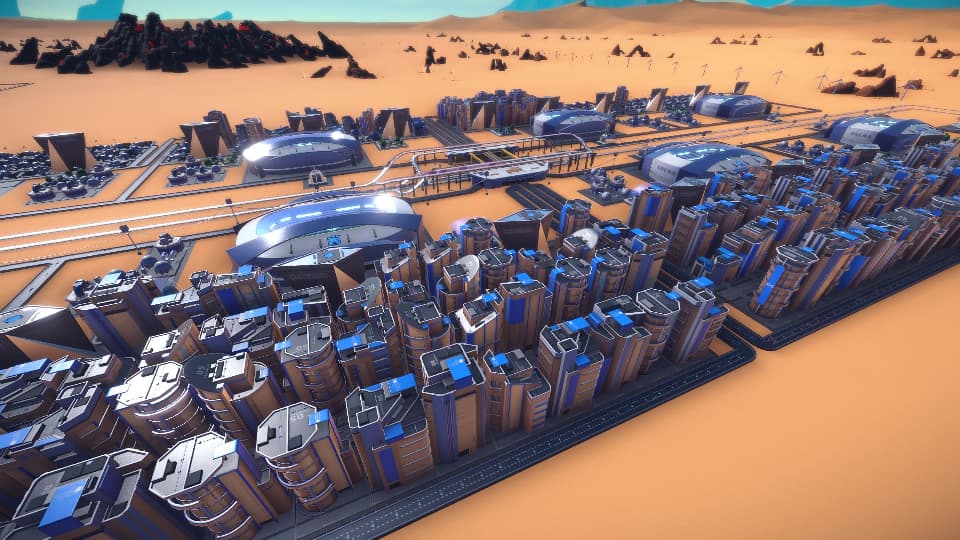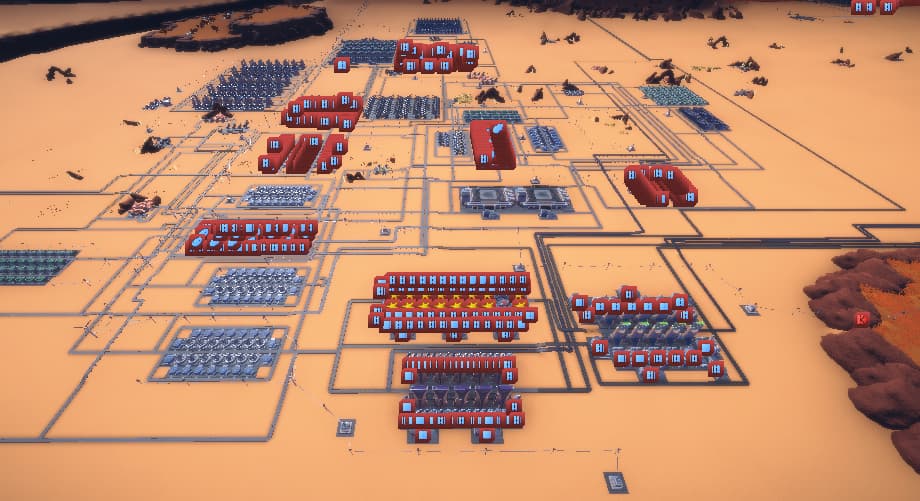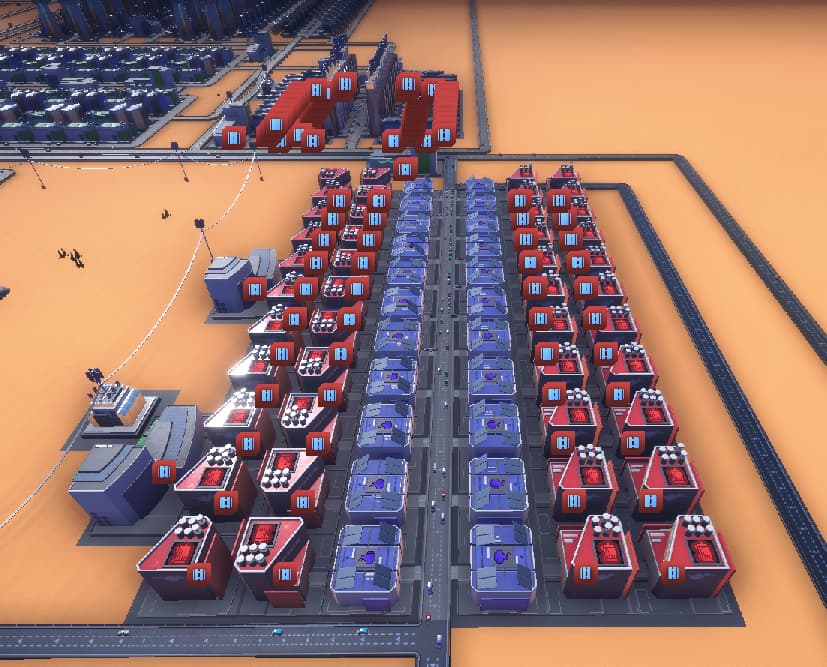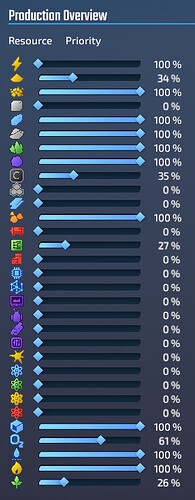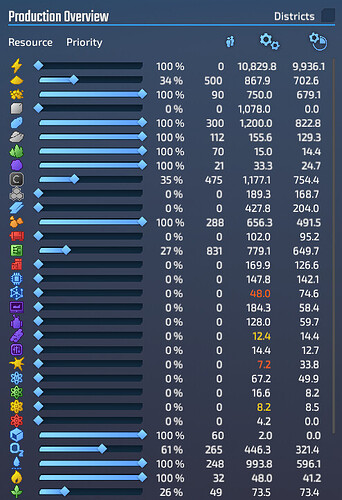Let me preface this with:
I wonder if this will get patched.
It has been a little over 3 years since we started our settlement on Neper. Today, the vice captain of our ship Antares came to the surface for an inspection of our colonization efforts. I, the interim mayor of Neper Alpha, what we call our main settlement, welcomed him and informed him of our recent breakthrough in research: A project we call “Red Science”. Maybe it would open up prospects of terraforming our new home.
“Having a look at your habitats I must say it looks quite impressive. Although it seems there is an oxygen shortage among some of the settlers?”, the vice captain inquired. “Oh yes. The size of our settlement has outgrown the infrastructure we put in place for it. We applied a new technology called Lightning Rails, a fruit of our recent endeavors in Red Science, to alleviate the shortage.” I replied full of pride.
“Don’t forget that your main goal is still to find and, if possible, mine adamantine. It is of vital importance for the repair of the Antares, which remains our only means of ever leaving the system,” the inspector reminded me. Then he went on: “All right, how many people are living here at the moment?” I quickly draw up a holo display and show him the numbers.

I saw some serious wrinkles on his frowning forehead as he saw the statistics. With an incredulous tone in his voice, he asked “This settlement only has 4000 inhabitants at the moment? And even if all your housing capacity will be used, you can make that 5000 at most. Didn’t you talk about the idea of terraforming Neper in the near future? How is that supposed to work?”
Then he finally noticed that number in the bottom center. “What is this huge number, 17659? Isn’t that the workforce Neper Alpha is currently requiring to run its operations?” he asked, full of doubt. The inspector began to develop a feeling that something was not quite going the right way here on the surface.
“Well, let’s inspect your production and industry area next.” he demanded. I complied and brought up the operation monitor overview on the holo display.
The vice captain was staring at the display in disbelieve. “Why are there so many warnings in your production centers?”, he asked very angrily. “Doesn’t this sign mean that the building is not connected to the road?” He used some finger gestures to zoom in on one of the areas.
“Yes, that symbol really means the buildings are not reachable by any road. What are all those motor factories around the home robot factories doing there? Some of them cannot even be connected to a road because you completely surrounded them!” He was about to lose his temper. I just shrugged and replied “Well, this is-”.
But he cut me short. He operated the console himself and drew up the production overview.
He couldn’t quite believe what he was seeing and started to seriously shout at me: " WHY IS NOBODY WORKING ON ANYTHING ADVANCED IN NEPER ALPHA? YOU’RE ONLY DOING SOME MINING AND THAT’S ALL???" He was now firmly believing that the captain put an utterly incompetent baboon in charge of their planetary settlement.
I was intimidated by the vice captain’s outburst (he was a tall, big man, after all). With a shaking hand I pointed at the holo display and tried to redeem myself with an explanation. “But sir, please have a look a little further to the right. Nobody is working in those buildings because we don’t need them to.” I showed him the output of our production facilities:
“For example, we are churning out an impressive one thousand galactic units of concrete each minute without anybody having to lift a finger in our concrete factories.” The inspector was speechless. “Wait, what…” My confidence was coming back to me. I indicated some other entries in the list to make my point. “Science packs, advanced consumer goods and high tech products. We don’t need any workforce to run all those things. That 17k number you saw in the citizen overview, that’s just a stupid bug in data collection module. It calculates all buildings as if they were run by actual people.” I explained.
The vice captain was clearly surprised. He didn’t expect to find this when he came down to the surface for the inspection. “But how do you…?” he asked bewildered.
Yes, how do I? Well, the other day I noticed that buildings can produce even without any workers in them and thought I’d try to put this to the extreme. I call this strategy the “Ghost town build”, because you’re running your settlement with a lot of empty buildings, thus requiring far less citizens in total. The key is the proximity production bonus. This bonus of 8% is awared for each building in range, and it is added to the building’s efficiency as calculated by worker occupancy. So a full building with 1 proximity bonus will run at 108%. An empty building with 1 proximity bonus will still run at 8%, however. Unlike other bonuses like FTL upgrades and high tech tools, which are multiplicative and thus useless with 0 workers, the proximity bonus will work to the full extent even if nobody is occupying the building.
As a quick side note, if this were to be patched, I think the best way would be for the proximity bonus to also work in a multiplacitve way, rather than additive.
So I am running the mining buildings at 100%, because they can’t gain any efficiency from proximity and can only be placed in certain limited spots. The other sources that don’t benefit from any proximity like water, sand and carbon, you can put anywhere you want and any amount. I run those at 1 worker per facility, which is the least you can do to get consistent results (if you use less than 1 on average, they will not be spread out evenly across the map). Then the buildings that need one of those things I put around them and not let any workers work in them, so 0% occupancy. They will produce merely from the proximity bonus. Let’s look at one of my concrete districts to illustrate:
I have 15 small sand mines and 1 person working in each of them. I put the concrete factories in their proximity and balanced production and proximity bonus out in such a way that the concrete factories just use up what the mines produce. Sulfur is coming from 100% mines.
Now the awesome thing about this is that, once you have a building that can run at 0% workers, all other buildings down the production chain that need this building’s output can also run at 0%, because you can surround it with its input producer which already runs at 0%. You can look at the home robot example above. They have 0% workers, because I can surround them with motor factories, which are also 0% only and they are next to the home robots only for the proximity bonus. Motors I can produce solely off of the proximity bonus of steel mills. And steel mills run at 0% because they are surrounded by low-employment (1/3) carbon processors and water producers. The science chain is another great example. I manage blue science already with 0% workers, and thus green science can be surrounded by blue science, yellow can be surrounded by green science and red science can be surrounded by yellow. Those surrounding buildings are not producing themselves, they only give the proximity bonus. Since they have 0 workers, they won’t tax my workforce. But the game thinks they should, thus my required jobs are completely off. I don’t even need those 4000 people to run my city in its current state, I need about 3000 or so. The worst sink are electronics, because I can’t produce those at 0% workers.
This is a really fun strategy that I may try again. It required some learning about which layouts and proportions are the most effective, so I guess I could do it better next time. But I have to admit it’s not as overpowered as I thought it would be. Using this strategy to greatly reduce your worker count has some drawbacks:
- You need a lot more building material. A lot more. You need all those bonus giving buildings which are otherwise useless and the higher you go in the value chain, the more expensive they become.
- You need a lot more electrical power. This is manageable, but also taxes building resources.
- You need more space. Not a big problem, because you also save space for habitats and stuff.
- You don’t have an accurate number for required workers. The game only shows you how much you would need if every building would be occupied 100%. It ignores your production sliders.
- You can’t simply stop producing most things. This was an unexpected one. Sometimes you want to stop producing one thing so its inputs (I’m look at you two, Neural Processors and Nanotubes!) are temporarily required somewhere else. Since your high-value production buildings run at 0% workers already, you have no way of turning them “off” by moving the worker slider to the left. Can only cut the road to them.
Another advantage is that you don’t really need to bother with Industrial robots and high tech tools. The robots are most effective at 100% occupied buildings, which are only the mines basically, and high tech tools are the most effective the higher the building’s efficiency already is. Well, most of my buildings are not very efficient, because proximity bonus only brings them up to 32-64% usually. Also, I could just build more of them, they cost me 0 workers anyway! The concrete is a good example. A 100% staffed concrete factory with both industrial robots and high tech tools still won’t be as worker/productivity efficient as mine. I need 0 workers to produce the concrete, it is mathematically impossible to be more efficient than that ![]() In the classic strategy you could optimize the sand and sulfur production with robots and tools, that’s right, but sulfur I can also optimize and then that just leaves sand, which I have to run at 1 person per mine, but it will still be more efficient than the traditional way.
In the classic strategy you could optimize the sand and sulfur production with robots and tools, that’s right, but sulfur I can also optimize and then that just leaves sand, which I have to run at 1 person per mine, but it will still be more efficient than the traditional way.

